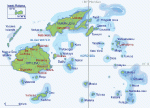Natural Disasters: Fijian Case Study
Irshad Ali, Save the Children Fiji
Natural disasters are regular occurrences in Fiji and affect people across the country in many ways – cyclones, floods, landslides, and drought. Although these disasters have some links with seasons, they are not completely predictable, nor are they assiduously tracked or mapped. Overall, a system-wide response to disasters is undertaken at national and local levels by aid agencies, non-governmental organisations (NGOs), and the government, which result in relief interventions.
The impact of a drought is not so clearly visible, compared with cyclones and floods. Droughts are slow onset disasters and their impacts are usually underestimated. The community and aid agencies' responses to them also tend to be delayed, and therefore add to the hardships of vulnerable communities.
During 1997-98, Fiji faced its worst drought which nearly crippled the economy, as the sugar cane harvest was reduced by nearly 50%, and affected other traditional crops such as yaqona, coconuts, and cocoa, which took years to recover. Accompanying disasters are the social consequences, including increased incidences of diseases, school absenteeism, and other social and family problems resulting from the stress of lost income.
Recently Fiji has been facing more drought-like conditions, especially in the last quarter of 2004, where the Western Division of Fiji’s main island of Viti Levu (see map below) experienced dry conditions. These dry conditions prevailed in the sugarcane and agricultural belt from Ba, Tavua, and Rakiraki.

Impacts
In late 2004 and early 2005 Save the Children Fiji (SCF) assessed the impact of the current dry conditions on children. The first assessment revealed that families could only look forward to a bleak holiday period with a real possibility of farmers experiencing lingering effects of this event in early 2005. The SCF visited the Divisional Officers in the affected regions to ascertain the impacts of this event. The following section describes the findings in detail.
Rakiraki
The visit to Rakiraki Divisional Officers (DOs) showed that the worst areas affected stretched from Drauniivi to Navesau (close to Tailevu), with Nanuku being the most serious. From October 2004, the DOs office supplied emergency water to an estimated 2200 farmers or 22,000 of families.
Tavua
The Divisional Office – Tavua informed SCF that there are 23 areas in total that have been receiving emergency water since October 2004, involving 682 households, with a population of 3594.
Ba
The assessment for this region was through visits to the Health Inspectors, rather than the District Office. SCF was informed that the areas affected are mainly inland and areas which do not have piped water supply, involving 117 families or a population of 600.
School visits
The SCF team also visited schools in the areas affected to determine the direct effects on children.
- Enrolment numbers alone, although indicating a slight decline, do not show the true picture, as the majority of the students enroled are still to pay school fees, and buy books and uniforms.
- While children of farmers are also exposed to the adverse effects of the drought, it is the children of the farm labourers that are worst affected, as their parents choose to migrate to Nadi and Lautoka (larger towns and cities) in search of work. Whether or not they are able to continue school at their new homes is unclear.
- School principals are trying to encourage parents to send their children to school e.g. agreeing to a payment plan for the parents to meet their children’s school fees etc.
- School principals believe that the worst is yet to come.
It has become increasingly clear through this assessment that the children who have been worst affected by the drought are those living in the Tavua areas and parts of Rakiraki. An estimate of the affected children is 5,000-8,000. The supply of emergency water to some of the affected areas is highly appreciated. However, much more concerted effort is needed to help retain children at school, and to avoid long-term effects on the education of children in the affected areas.
The immediate needs of children must be given thorough consideration. The nutritional situation of children is of grave concern. While health problems are not so visible among children visited, support is needed for nutritional interventions for children and families. Teachers observe progressive impoverishment of children. Food is in short supply – lacking fresh vegetables, pulses, and basic supplies. The decline in the quality of lunch children take to school is a concern raised by many teachers in the schools visited. Children under 5 and pregnant and lactating women, will be particularly vulnerable.
Children will be adversely affected by lack of good nutrition. The lack of food and water may lead to other health risks. While major health conditions were not so evident among the children visited, many were reluctant to divulge information on the family food supply. Primary school children in most schools were encouraged to share lunch with those unable to afford it. According to teachers, secondary school children would rarely admit to not having lunch and make excuses to avoid embarrassment. They would rather do without lunch to avoid any embarrassment. Teachers have further observed irritable behaviour and a decline in concentration among children severely affected.
With a lack of employment opportunities in the area, many families are gradually becoming mobile. Reports indicate that the most affected are farm labourers who either move with their families or leave children in the care of one parent or relatives. A key issue will be to ensure that children remain with their families since they are their primary protectors. It is important to avoid separation of children as this tendency is likely to contribute towards larger social problems. Preventing separation and actively facilitating school-based interventions io the crisis must be key components of any emergency response.
